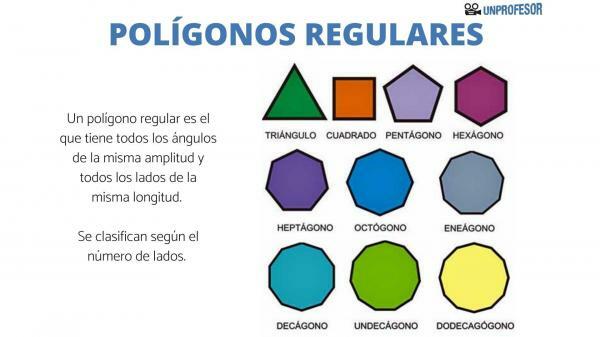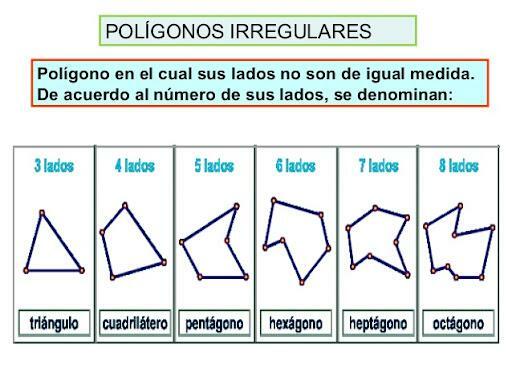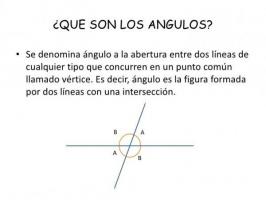REGULAR and IRREGULAR polygons

In this lesson that we bring you from a Teacher we are going to study what and what are the regular and irregular polygons with examples so that it is much better understood. In addition, we will do some exercise and see your solutions. If what you are looking for is a much more exhaustive classification of regular polygons or irregular polygons, you can browse our website.
Index
- What are regular and irregular polygons
- Examples of regular polygons
- Examples of irregular polygons
- Regular and Irregular Polygons Exercises
- Solution
What are regular and irregular polygons.
The polygons are what is understood in geometry as plane figures with a certain number of sides that encompass a region of a plane in a finite way. Those sides that form the segments of the figure are known as edges and the point where two edges meet is called the vertex or corner. In each of these vertices, two angles are generated, the interior and the exterior, which is simply the amplitude generated at the vertex.
There are different classifications for polygons, but in this article we will talk about the regular and irregular polygons.
- Regular polygons. They are those that have all the angles of the same amplitude and all the sides of the same length.
- Irregular polygons. They are the ones that either have the sides of equal length, but angles of different amplitude; or they have sides of different lengths, but angles of the same width; or they have sides of different lengths and angles of different widths.
Examples of regular polygons.
Regular polygons can be infinite, so let's see a sample of examples of this type of polygon with the number of sides that each of them have:
- Equilateral triangle: 3
- Square: 4
- Regular Pentagon: 5
- Regular hexagon: 6
- Regular heptagon: 7
- Octagon or regular octagon: 8
- Aenea or regular nonagon: 9
- Regular decagon: 10
- Endecagon or regular undecagon: 11
- Regular dodecagon: 12
- Tridecagon or regular triskaidecagon: 13
- Regular tetradecagon: 14
- Pentadecagon or regular pentedecagon: 15
- Regular Hexadecagon: 16
- Regular heptadecagon: 17
- Octadecagon or regular octadecagon: 18
- Enneadecagon or regular nonadecagon: 19
- Isodecagon or regular icosagon: 20
Freehand it is very difficult, practically impossible, to draw a regular polygon, because inadvertently one side can be longer than the other. For this reason, there are currently generators that draw regular polygons by computer.

Examples of irregular polygons.
Irregular polygons they can also be infinite, so we are going to see a selection of examples of these polygons with the number of sides that each of them have:
- Non-equilateral triangle: 3
- Quadrilateral (rhombus, rectangle, rhomboid, trapezoid, trapezoid): 4
- Irregular Pentagon: 5
- Irregular hexagon: 6
- Irregular heptagon: 7
- Octagon or irregular octagon: 8
- Eneagon or irregular nonagon: 9
- Irregular decagon: 10
- Endecagon or irregular undecagon: 11
- Irregular dodecagon: 12
- Tridecagon or irregular triskaidecagon: 13
- Irregular tetradecagon: 14
- Pentadecagon or irregular pentedecagon: 15
- Irregular Hexadecagon: 16
- Irregular heptadecagon: 17
- Octadecagon or irregular octadecagon: 18
- Enneadecagon or irregular nonadecagon: 19
- Isodecagon or irregular icosagon: 20
As you may have already noticed, simply change the surname "regular" or "irregular" in most polygons, except the first ones. This is so because the number of sides is the same, even though they are of different lengths. Actually, if you draw several lines of different lengths that meet without making indentations, you will easily have an irregular polygon.

Regular and irregular polygons exercises.
We are going to do the following exercises to see if you have understood well the difference between regular and irregular polygons and know how to name some of them:
- Reflect: is a circle a regular or irregular polygon?
- Find in the following image regular and irregular polygons and name them:

Solution.
Let's go to see her answer to the exercises:
- A circle is considered to be a regular polygon with infinite sides.
- Although the answer is open, some of the polygons that you have been able to find are the following: the square that shapes the bathroom in the center of the drawing (polygon regular), the triangle that shapes the roof (irregular polygon), the rectangular window of the room (irregular polygon), the circular window of the roof (regular polygon of infinite sides) ...
If this article has been of interest to you, do not forget to share it with your classmates and continue browsing through the tabs on our website. We recommend the Geometry section, so that you continue learning about polygons.
If you want to read more articles similar to Regular and irregular polygons - examples, we recommend that you enter our category of Geometry.


